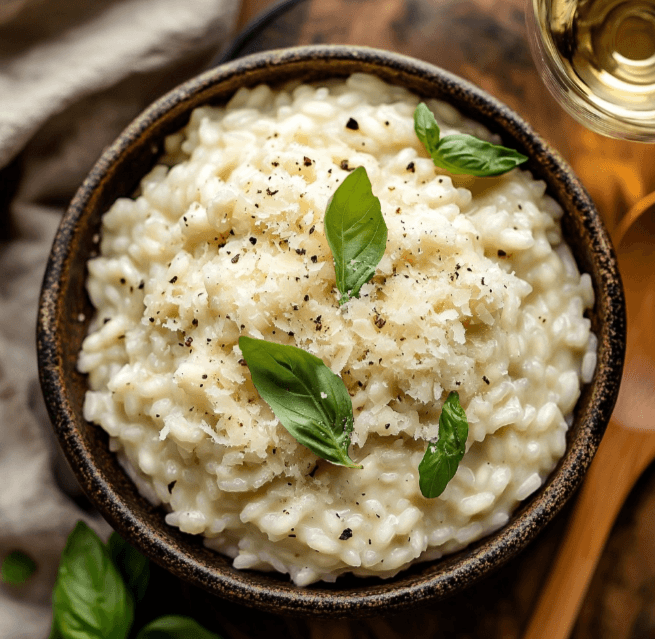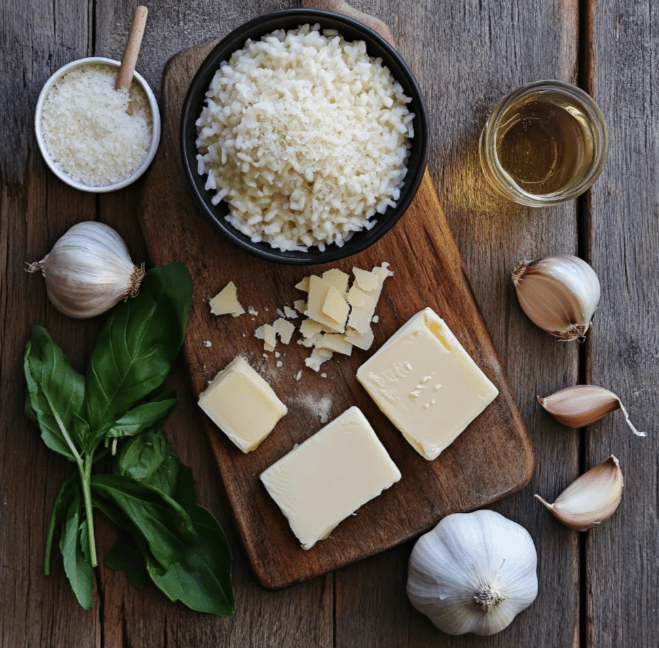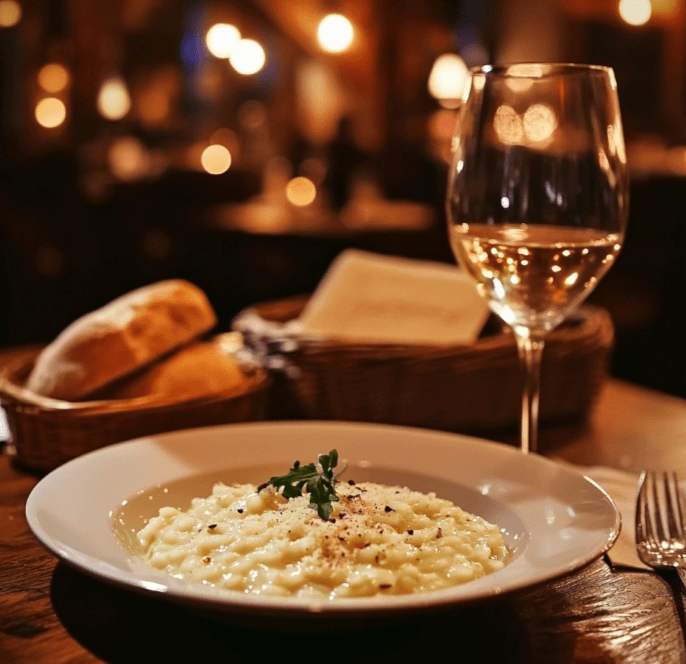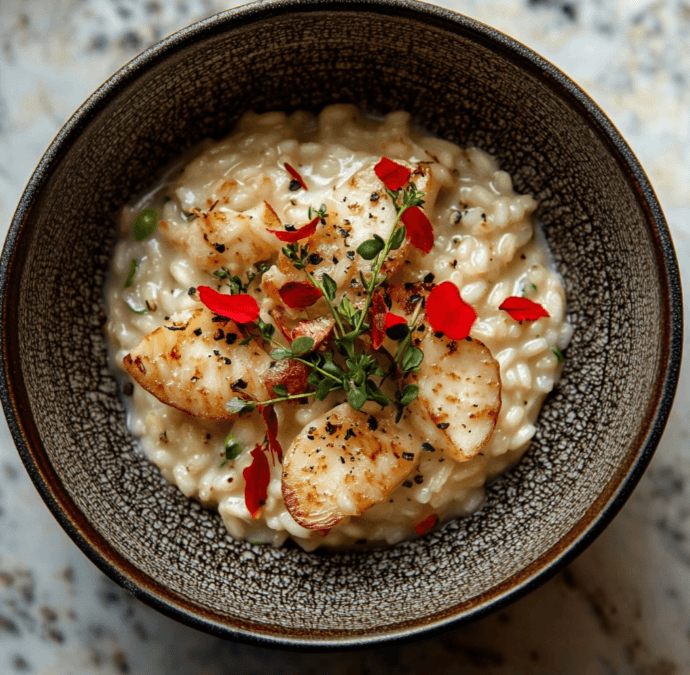Authentic risotto is more than just a dish—it’s a creamy, comforting masterpiece that embodies the essence of Italian cuisine. Made with simple yet high-quality ingredients, this traditional northern Italian rice dish is famous for its rich texture and delicate balance of flavors. But what makes authentic risotto truly special? It’s the technique—the slow addition of warm broth, the gentle stirring, and the patience required to achieve that perfect, velvety consistency. Whether you’re a home cook or an aspiring chef, mastering the art of making authentic risotto is a rewarding culinary experience that will elevate your cooking skills to a whole new level. 🍚✨
Table of Contents
What is Risotto?
Risotto is a northern Italian rice dish cooked with broth until it reaches a creamy consistency. The broth can be derived from meat, fish, or vegetables. Many types of risotto contain butter, onion, white wine, and parmesan cheese. It’s often described as a labor of love, requiring constant attention and stirring to release the rice’s starches, creating its signature silkiness.

The History of Risotto in Italian Cuisine
The story of risotto begins in the north of Italy, particularly in Milan. The introduction of rice into Italy was a lengthy process that started during the Middle Ages, and it was the Spaniards under the Milanese rule in the 14th century who introduced rice cultivation. It wasn’t until the 19th century that risotto as we know it began to take form in Milan, celebrated for its combination of local ingredients to create something truly sublime. Dive deeper into the history of this dish with our detailed exploration “What Was the Original Sloppy Joe Made With?”, which offers insights into culinary history.
Choosing the Right Ingredients
Best Rice Types for Making Risotto
Not all rice is created equal, especially when it comes to making risotto. The stars of the show are usually Arborio, Carnaroli, and Vialone Nano. Arborio rice is widely available, but Carnaroli is often preferred by chefs for its higher starch content and firmer texture, which keeps al dente even after cooking.
To whip up a truly authentic risotto, you’ll need a few key ingredients:
- Stock: Chicken, vegetable, or seafood stock is the base flavor.
- Onion and Garlic: For foundational flavors.
- Butter and Olive Oil: For sautéing and adding richness.
- White Wine: Adds acidity and depth.
- Parmesan Cheese: For creamy texture and cheesy goodness.
- Salt and Pepper: Essential for seasoning.

A small block quote to ponder:
“Risotto does not reward the impatient cook. The slower you cook it, the creamier it gets.”
Step-by-Step Guide to Cooking Perfect Risotto
Preparing Your Ingredients
Before you even turn on the stove, get all your ingredients prepped and ready to go. This is called mise en place, a French term that literally means “everything in its place.” Measure your broth and keep it simmering in a pot next to where you’ll be cooking the risotto. Dice your onions, mince your garlic, and if you’re adding any vegetables or proteins, prepare them too.
The Toasting Phase: Why It’s Crucial
Start by melting some butter in a large pan over medium heat. Add your onions first, cooking until they are soft and translucent. Then, stir in the garlic and let it cook for about a minute until fragrant. Add the rice, stirring quickly to coat it with the butter and toast it lightly. Why do this? Toasting helps to coat each grain in fat, which helps to control the absorption rate of the liquid, and that’s crucial for that perfect texture.
Mastering the Art of Liquid Absorption
Add a splash of white wine first, stirring until it’s nearly all absorbed. This not only adds flavor but also deglazes the pan, picking up any flavorful bits stuck to the bottom. Then, begin adding your warm broth, one ladle at a time, stirring constantly. Each addition should only be made once the previous amount has been absorbed. This slow, constant stirring helps to agitate the rice’s surface, releasing starches and creating that hallmark creamy texture. 🍚

Common Risotto Cooking Mistakes
When mastering the art of preparing authentic risotto, it’s essential to avoid common pitfalls that can impact the texture and flavor of this classic dish.
Overstirring: The Risks of Too Much Attention
While consistent stirring is crucial for releasing the starches that give authentic risotto its creamy texture, there is such a thing as too much stirring. Excessive agitation can break down the rice grains, resulting in a gloppy rather than glossy finish. The key is to stir gently and only as often as necessary to keep the rice from sticking. Let the risotto sit briefly between stirs to ensure even cooking and perfect consistency.
Underseasoning: The Importance of Balancing Flavors
A common mistake in risotto preparation is underseasoning. Authentic risotto should be well-seasoned from its base to ensure the final dish is flavorful. Since the rice absorbs the broth it’s cooked in, make sure your broth is tasty and well-salted. Regular tasting is crucial; adjust with salt and pepper as needed to layer the flavors beautifully.
Ignoring the Rice’s Cooking Point
Achieving perfectly cooked rice is the pinnacle of making authentic risotto. The ideal texture is ‘al dente’—firm to the bite at the center of the grain. It’s easy to overcook risotto, turning it mushy. To avoid this, begin testing the rice a few minutes before the estimated cooking time is up. This timely check helps you catch the rice at the perfect moment, preserving its ideal texture.
Professional Tips for Flawless Authentic Risotto
Elevate your authentic risotto with tricks from culinary experts that ensure a fail-proof dish every time.
The Role of Stock in Risotto
The choice of stock is crucial in risotto-making, acting as the backbone of flavor. For the best authentic risotto, use a high-quality homemade stock that complements your risotto’s theme, whether it’s vegetable, chicken, or seafood. Keeping the stock simmering adjacent to your cooking risotto helps maintain a consistent cooking temperature, allowing for better absorption and a smoother cooking process.
When and How to Add Cheese
Adding Parmesan cheese is a final step that can make or break your authentic risotto. To avoid a grainy texture, incorporate the cheese off the heat, stirring gently to melt the cheese through the warm risotto. This method ensures your risotto remains creamy and rich, capturing the essence of true Italian cuisine.
Adjusting Texture Before Serving
Authentic risotto should have a certain fluidity when plated—it should gently spread without being runny. If your risotto thickens up too much upon resting, a ladle of hot stock stirred in just before serving can restore its creamy consistency. This adjustment, known in Italian as “all’onda” or “like a wave,” is crucial for achieving the perfect risotto texture.
Advanced Techniques and Variations
Explore beyond the basics with these suggestions to enhance your authentic risotto.
Incorporating Seafood or Vegetarian Options
Authentic risotto serves as a fantastic base for a variety of ingredients. For a luxurious seafood risotto, consider adding perfectly cooked scallops or prawns towards the end of cooking to ensure they remain tender and juicy. For a hearty vegetarian option, rich, earthy mushrooms or sweet, caramelized butternut squash can add both flavor and substance to your dish.
Truffle Risotto: Elevating Your Dish to Gourmet Levels
For an opulent twist, finishing your authentic risotto with a drizzle of truffle oil or a sprinkle of fresh truffle shavings can transform your meal into a gourmet experience. The earthy flavors of truffles blend seamlessly with the creamy texture of the risotto, offering a sophisticated touch to this hearty dish.
Pairing Wine with Authentic Risotto
Selecting the right wine to complement your authentic risotto can enhance both the meal and the overall dining experience. Lighter risottos, such as those featuring lemon or asparagus, pair beautifully with a crisp white wine like Sauvignon Blanc. For richer varieties, such as mushroom or saffron risotto, a full-bodied Chardonnay or even a light red, such as Pinot Noir, can be delightful choices.

How to Serve and Present Risotto
Presentation matters, especially when you’ve put so much effort into cooking authentic risotto. Serve it in shallow bowls to showcase its creamy consistency. Garnish with a little extra Parmesan, a drizzle of quality olive oil, and perhaps some fresh herbs like parsley or basil to add color and freshness.
Storing and Reheating Tips
Authentic risotto is best enjoyed fresh, but if you have leftovers, they can be stored in the refrigerator for a couple of days. To reheat, add a splash of stock or water and warm it over low heat, stirring gently. The risotto should regain its creamy texture, making for a delightful next-day meal.
With these insights and tips, your journey to mastering authentic risotto is well on its way to becoming a satisfying and delicious adventure in your culinary repertoire. Stay tuned for more insights on troubleshooting common issues and serving your risotto like a seasoned chef! 🍴
Solving Common Risotto Problems
Even the most experienced cooks can encounter issues when preparing authentic risotto. Here’s how to troubleshoot some typical problems, ensuring your risotto turns out impeccably every time.
Fixing Undercooked Rice
If you find your rice is still too hard after all the stock has been absorbed, don’t panic—this is a common hiccup in making authentic risotto. The solution is simple: add a little more hot stock and continue cooking it gently. The key is to add just enough liquid to finish cooking the rice without making the dish soupy.
Rescuing Overcooked Risotto
Overcooking is a risk when aiming for that perfect ‘al dente’ texture in authentic risotto. If your risotto has passed this stage and feels a bit too soft, stop adding any more liquid. To serve it, spread it out on a wide plate to stop the cooking process and prevent it from becoming mushier. Enhance the flavor with a generous sprinkle of Parmesan cheese and fresh herbs to divert attention from the texture.
Balancing Overly Rich Flavors
Sometimes, the richness of authentic risotto can be overwhelming, especially if there’s a heavy hand with the cheese or butter. If it tastes too rich, introduce an acidic component like a squeeze of lemon juice or a dash of white wine vinegar to cut through the fat and balance the flavors beautifully.
Conclusion: Enjoying and Sharing Your Risotto
With these detailed insights and practical tips, you’re now equipped to tackle the challenge of making authentic risotto that could rival any Italian grandmother’s recipe. It’s a dish that rewards patience and precision, and now you have the knowledge to excel at it. Remember, each batch of risotto is an opportunity to refine your technique and explore new flavors. Buon appetito! 🍴✨
For more culinary adventures and to explore other classic dishes, check out our comprehensive guide to other delicious recipes like “The Ultimate Guide to the Perfect Smoked Salmon Dip” and explore new tastes and techniques that will enhance your cooking repertoire.

